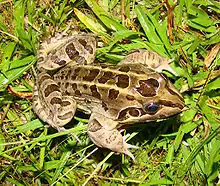Leptodactylus latrans
Leptodactylus latrans is a species of frog in the family Leptodactylidae.[2] It is native to much of South America east of the Andes, and Trinidad and Tobago.[1] It has many common names, including rana criolla, sapo-rana llanero,[3] butter frog, and lesser foam frog.[4]
| Leptodactylus latrans | |
|---|---|
 | |
| Scientific classification | |
| Domain: | Eukaryota |
| Kingdom: | Animalia |
| Phylum: | Chordata |
| Class: | Amphibia |
| Order: | Anura |
| Family: | Leptodactylidae |
| Genus: | Leptodactylus |
| Species: | L. latrans |
| Binomial name | |
| Leptodactylus latrans (Steffen, 1815) | |
| Synonyms | |
| |
Habitat and ecology
This is a common species in many parts of its range. It can be found in a variety of habitat types, including swamps, savannah, grasslands, and tropical forest ecosystems.[3] It tolerates disturbed habitat and can be seen in gardens and urban areas.[3] It breeds in temporary water bodies, such as ponds and floodplains, where it creates a foam nest for its eggs.[3] In some cases, one parent, usually a female, guards the tadpoles and attacks potential predators.[5]
Taxonomy
This taxon is considered to be a species complex, or a component of one, and taxonomic studies may distinguish several different species among its populations.[6]
References
- Ronald Heyer, Jose Langone, Enrique La Marca, Claudia Azevedo-Ramos, Ismael di Tada, Diego Baldo, Esteban Lavilla, Norman Scott, Lucy Aquino, Jerry Hardy (2010). "Leptodactylus latrans". IUCN Red List of Threatened Species. 2010: e.T57151A11592655. doi:10.2305/IUCN.UK.2010-2.RLTS.T57151A11592655.en. Retrieved 14 November 2021.
{{cite journal}}: CS1 maint: multiple names: authors list (link) - Lavilla, Langone, Caramaschi, Heyer & de Sá (2010). The identification of Rana ocellata Linnaeus, 1758. Nomenclatural impact on the species currently known as Leptodactylus ocellatus (Leptodactylidae) and Osteopilus brunneus (Gosse, 1851) (Hylidae). Zootaxa 2346: 1–16
- Heyer, R., et al. 2010. Leptodactylus latrans. The IUCN Red List of Threatened Species 2010. Retrieved 21 January 2018.
- Leptodactylus latrans. Amphibian Species of the World 6.0. American Museum of Natural History.
- Vitt, Laurie J.; Caldwell, Janalee P. (2014). Herpetology: An Introductory Biology of Amphibians and Reptiles (4th ed.). Academic Press. p. 175.
- Heyer, W. R. (2013). Morphological analyses of frogs of the Leptodactylus latrans complex (Amphibia, Leptodactylidae) from selected localities in South America. Proceedings of the Biological Society of Washington: January 2014, Vol. 126(4) 369-78.
Further reading
- Bogart, J. P. (1974). A karyosystematic study of frogs in the genus Leptodactylus (Anura: Leptodactylidae). Copeia, (3), 728–737.
- Heyer, W. R. (1969). The adaptive ecology of the species groups of the Genus Leptodactylus (Amphibia, Leptodactylidae). Evolution, 23, 421–428.
- Prado, C. P. de A., Uetanabaro, M., Haddad, C F. B. (2002). Description of a new reproductive mode in Leptodactylus (Anura, Leptodactylidae), with a review of the reproductive specialization towards terrestriality in the genus. Copeia, 2002(4), 221–245.
